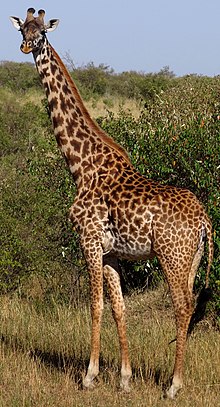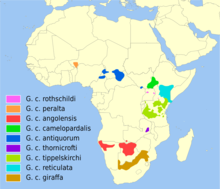Giraffa tippelskirchi
| Masai giraffe | |
|---|---|
 |
|
| A Masai giraffe. | |
| Scientific classification | |
| Kingdom: | Animalia |
| Phylum: | Chordata |
| Class: | Mammalia |
| Order: | Artiodactyla |
| Family: | Giraffidae |
| Genus: | Giraffa |
| Species: | G. camelopardalis |
| Subspecies: | G. c. tippelskirchi |
| Trinomial name | |
|
Giraffa camelopardalis tippelskirchi (Matschie, 1898) |
|
 |
|
| Range map in light green | |
The Masai giraffe (Giraffa camelopardalis tippelskirchi), also spelled Maasai giraffe, also called Kilimanjaro giraffe, is the largest species of giraffe native to East Africa, also the tallest land mammal. The Masai giraffe can be found in central and southern Kenya and in Tanzania. It has distinctive, irregular, jagged, star-like blotches which extend to the hooves. A median lump is usually present in males.
The Masai giraffe was described and given its binomial name Giraffa tippelskirchi by German zoologist Paul Matschie in 1898. The Masai giraffe was named in honor of Herr von Tippelskirch who was a member of a German scientific expedition in German East Africa to what is now northern Tanzania in 1896. Tippelskirch bought back the skin of a female Masai giraffe from near Lake Eyasi which was later on identified as Giraffa tippelskirchi. The IUCN currently recognizes only one species of giraffe with nine subspecies. However, alternative taxonomies have proposed Masai giraffes be considered a unique species.
The Masai giraffe is distinguished by jagged spots on its body, geographic range including southern Kenya, all of Tanzania, and the Luangwa Valley in Zambia, and genetic evidence. It is the largest-bodied giraffe species.
All giraffes are considered Vulnerable to extinction by the IUCN, and the Masai giraffe population declined 52% in recent decades. Overall, the approximate number of all populations accumulate to 32,550 in the wild. Demographic studies of wild giraffes living inside and outside protected areas suggest low adult survival outside protected areas due to poaching, and low calf survival inside protected areas due to predation are the primary influences on population growth rates. Survival of giraffe calves is influenced by the season of birth, and the seasonal local presence or absence of long-distance migratory herds of wildebeest and zebra. Metapopulation analysis indicated protected areas were important for keeping giraffes in the larger landscape.In situ conservation of Masai giraffes is being done by several government agencies including Kenya Wildlife Service, Tanzania National Parks, Zambia Wildlife Authority; and non-governmental organizations including PAMS Foundation, Wild Nature Institute, and Giraffe Conservation Foundation. At the several zoos, Masai giraffe have become pregnant and successfully given birth.
...
Wikipedia

